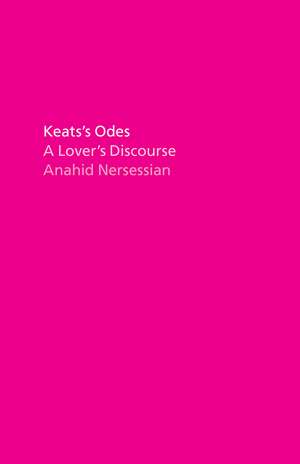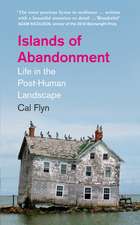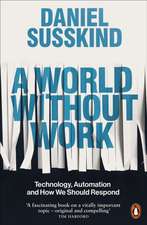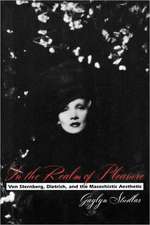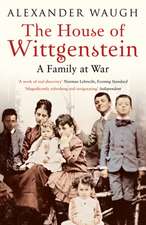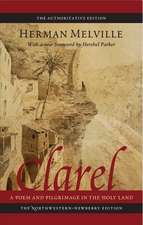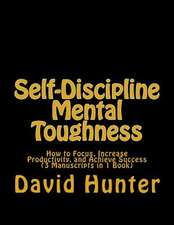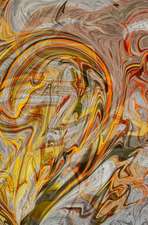Keats's Odes: A Lover's Discourse
Autor Professor Anahid Nersessianen Limba Engleză Paperback – 13 dec 2022
In 1819, the poet John Keats wrote six poems that would become known as the Great Odes. Some of them—“Ode to a Nightingale,” “To Autumn”—are among the most celebrated poems in the English language. Anahid Nersessian here collects and elucidates each of the odes and offers a meditative, personal essay in response to each, revealing why these poems still have so much to say to us, especially in a time of ongoing political crisis. Her Keats is an unflinching antagonist of modern life—of capitalism, of the British Empire, of the destruction of the planet—as well as a passionate idealist for whom every poem is a love poem.
The book emerges from Nersessian’s lifelong attachment to Keats’s poetry; but more, it “is a love story: between me and Keats, and not just Keats.” Drawing on experiences from her own life, Nersessian celebrates Keats even as she grieves him and counts her own losses—and Nersessian, like Keats, has a passionate awareness of the reality of human suffering, but also a willingness to explore the possibility that the world, at least, could still be saved. Intimate and speculative, this brilliant mix of the poetic and the personal will find its home among the numerous fans of Keats’s enduring work.
| Toate formatele și edițiile | Preț | Express |
|---|---|---|
| Paperback (1) | 79.37 lei 3-5 săpt. | |
| University of Chicago Press – 13 dec 2022 | 79.37 lei 3-5 săpt. | |
| Hardback (1) | 146.78 lei 3-5 săpt. | +13.06 lei 6-12 zile |
| University of Chicago Press – 10 feb 2021 | 146.78 lei 3-5 săpt. | +13.06 lei 6-12 zile |
Preț: 79.37 lei
Nou
Puncte Express: 119
Preț estimativ în valută:
15.19€ • 15.97$ • 12.55£
15.19€ • 15.97$ • 12.55£
Carte disponibilă
Livrare economică 27 martie-10 aprilie
Preluare comenzi: 021 569.72.76
Specificații
ISBN-13: 9780226826523
ISBN-10: 022682652X
Pagini: 160
Dimensiuni: 140 x 216 x 12 mm
Greutate: 0.18 kg
Ediția:First Edition
Editura: University of Chicago Press
Colecția University of Chicago Press
ISBN-10: 022682652X
Pagini: 160
Dimensiuni: 140 x 216 x 12 mm
Greutate: 0.18 kg
Ediția:First Edition
Editura: University of Chicago Press
Colecția University of Chicago Press
Notă biografică
Anahid Nersessian is professor of English at the University of California, Los Angeles. She is the author of The Calamity Form: On Poetry and Social Life, Utopia, Limited: Romanticism and Adjustment, and the coeditor of the Thinking Literature series, published by the University of Chicago Press.
Extras
John Keats was born on October 31, 1795, and he died of tuberculosis on February 23, 1821, aged twenty-five. In that narrow patch of existence he composed some of the most unrepentingly alive poems in the English language. It is possible that, had he survived, he would have written no more; quitting had always been an option, and he needed real money to support himself and his fiancée, Fanny Brawne. It is also possible that he would have kept writing, and possible too that he would have burrowed even deeper into the broken heart of his century, which, he knew, was reordering time and space in answer to the demands of a new and rapacious economic system. George Bernard Shaw saw in Keats the makings of “a full-blooded modern revolutionist,” and if he didn’t reach the barricades he did belong on them, because there was nothing Keats loved more than us: those who know this is not all we are meant to be. His poetry is a record of that love and its wild, inconvenient expression. It is a lover’s discourse, at once compassionate, exacting, indecent, and pure.
This book collects six of Keats’s poems, known together as the Great Odes. I follow each ode with a short essay that is both critical and autobiographical, although the autobiographical dimension will not always be obvious. In that sense, the essays work like the odes. Odes, roughly speaking, are poems meant to celebrate something or someone, but because they are written from a place of emotional excess or ferment it’s easy for them to tip over into more private preoccupations: thus Percy Bysshe Shelley’s “Ode to the West Wind,” which connects the cycle of the seasons to the here today, gone tomorrow movement of revolutionary struggle, also erupts into the furiously personal cri de coeur “I fall upon the thorns of life—I bleed!” In writing about Keats’s odes, I have tried to prop myself open to this same uneven traffic of literary and intimate concerns. This book, then, is a love story: between me and Keats, and not just Keats.
Keats himself was famously lovable, despite having been born (he said) into an “unpromising morning.” That sense of bleakness, of having failed before he had begun, dogged him. He was poor. He was short, six inches below average, and in ill health. Once he began publishing his work was almost universally panned. He was temperamental, obsessive, and thin-skinned, and his childhood, which was traumatic, left him “nervous, morbid,” in the words of his brother George. All the same, he amassed a small army of devoted friends, one of whom called him “the most lovable associate ... ‘that ever lived in the tide of times.’” Of his death, or perhaps their relationship, Brawne wrote, “I have not got over it, and never shall.”
When I say this book is a love story, I mean it is about things that cannot be gotten over—like this world, and some of the people in it.
The word that gets used most often in conjunction with Keats is sensuous. He is fascinated by how things feel, and by the capacity of metaphor to register the dizzying strangeness of being a body among others. Only Keats could come up with “the thrilling liquidity of dewy piping” or “a breathless honeyfeel of bliss,” and not always to his credit. The early poetry, like the soupy epic Endymion, expels an unfortunate phrase every couple of lines: “well-wooing sun,” “night-swollen mushrooms,” “fire-tailed exhalations,” and so on. This kind of writing disgusted contemporary reviewers, who called it “puerile” and “effeminate,” “unhealthy” and “unclean”; “In Wordsworth,” one sniffed, “there is no such unhealthy lusciousness.” Lord Byron agreed: “Such poetry,” he declared, “is a sort of mental masturbation,” and elsewhere he snickers about “Johnny Keats’s piss-a-bed-poetry.” A century later William Butler Yeats slides into the same vein:
I see a schoolboy when I think of him
With face and nose pressed to a sweet-shop window,
For certainly he sank into his grave
His senses and his heart unsatisfied,
And made—being poor, ailing and ignorant,
Shut out from all the luxury of the world,
The coarse-bred son of a livery stable-keeper—
Luxuriant song.
Yeats makes explicit what Byron doesn’t have to: not only is Keats’s poetry sexually deviant, its indecency (or “luxuriance”) is amplified by his lower-middle-class status. The Romantic period had a taste for so-called peasant poets like Stephen Duck, Ann Yearsley, and John Clare, but Keats was not a peasant. Worse, he skimmed the proletarian perimeter while being aspirationally “shabby-genteel,” “a fanciful dreaming tea-drinker” with a false claim on respectability. In the alchemy of nineteenth-century social prejudice, this rendered him at once oversexed and insufficiently masculine. He was an outcast and a striver and out of genital control, “f–gg–g his Imagination” (Byron again) instead of a nice warm body. It’s a singularly nasty assessment, and it sticks.
It sticks, in part, because when he died, Keats’s friends played up elements of this picture, and the Victorian era (which Keats missed by just nine years) ate it up. He was a special favorite of the Pre-Raphaelites, who mined his work for inspiration; in their poems and canvases, colorless young men repine in the arms of no-good women with hair like candy floss. He became then what he still is to many people now: an escapist, rolling around in visions of fairies and butterflies, deliriously aroused but somehow still chaste. In the big-box bookstores of my youth, you could always find cheap editions of his poems, squat volumes with gold paint sprayed along their edges. The checkout line held stacks of blank notebooks with Frank Dicksee’s 1901 painting La Belle Dame sans Merci spilled across the front and Keats’s more notable quotables— “I am certain of nothing but of the holiness of the heart’s affections and the truth of the imagination”—printed in the margins. The poetry, it seemed, was safe, commercial, decorative. Above all, it was apolitical.
This would have stuck painfully in Keats’s craw. The reason he got so much negative attention in the press is because he hung out with well-known radicals, and was a radical himself. When one reviewer dubbed Keats and his friends “the Cockney School of Poetry,” he didn’t just mean that they were, as the Brits say, N.O.C.D. (not our class, dear), he meant they were left-wingers, even revolutionaries. This is a view of Keats most academics now share, thanks in large measure to the legendary Walter Jackson Bate—who went from busing tables in campus dining halls to Harvard professor—whose 1963 biography turned Yeats’s picture of the schoolboy randy for candy on its head. Bate’s Keats was a bruiser, his Jacobin sympathies hung in plain sight. Today, if you suggest to a room full of Keats scholars that their man is apolitical, you might be asked to step outside.
The trouble with this view of Keats is that it rests heavily on his biography and not much, if at all, on his poetry. Although that poetry was written in dark times—in the aftermath of the Napoleonic Wars and in the middle of the catastrophic economic downtown they engendered; during the breakneck acceleration of the Industrial Revolution, with its unspeakable dependence on human slavery in the Caribbean and elsewhere; in the wake of the Peterloo Massacre, when armed cavalry maimed or killed a still-unknown number of peaceful protestors—it says close to nothing about them. Keats’s radicalism lies elsewhere, in his style.
This book collects six of Keats’s poems, known together as the Great Odes. I follow each ode with a short essay that is both critical and autobiographical, although the autobiographical dimension will not always be obvious. In that sense, the essays work like the odes. Odes, roughly speaking, are poems meant to celebrate something or someone, but because they are written from a place of emotional excess or ferment it’s easy for them to tip over into more private preoccupations: thus Percy Bysshe Shelley’s “Ode to the West Wind,” which connects the cycle of the seasons to the here today, gone tomorrow movement of revolutionary struggle, also erupts into the furiously personal cri de coeur “I fall upon the thorns of life—I bleed!” In writing about Keats’s odes, I have tried to prop myself open to this same uneven traffic of literary and intimate concerns. This book, then, is a love story: between me and Keats, and not just Keats.
Keats himself was famously lovable, despite having been born (he said) into an “unpromising morning.” That sense of bleakness, of having failed before he had begun, dogged him. He was poor. He was short, six inches below average, and in ill health. Once he began publishing his work was almost universally panned. He was temperamental, obsessive, and thin-skinned, and his childhood, which was traumatic, left him “nervous, morbid,” in the words of his brother George. All the same, he amassed a small army of devoted friends, one of whom called him “the most lovable associate ... ‘that ever lived in the tide of times.’” Of his death, or perhaps their relationship, Brawne wrote, “I have not got over it, and never shall.”
When I say this book is a love story, I mean it is about things that cannot be gotten over—like this world, and some of the people in it.
The word that gets used most often in conjunction with Keats is sensuous. He is fascinated by how things feel, and by the capacity of metaphor to register the dizzying strangeness of being a body among others. Only Keats could come up with “the thrilling liquidity of dewy piping” or “a breathless honeyfeel of bliss,” and not always to his credit. The early poetry, like the soupy epic Endymion, expels an unfortunate phrase every couple of lines: “well-wooing sun,” “night-swollen mushrooms,” “fire-tailed exhalations,” and so on. This kind of writing disgusted contemporary reviewers, who called it “puerile” and “effeminate,” “unhealthy” and “unclean”; “In Wordsworth,” one sniffed, “there is no such unhealthy lusciousness.” Lord Byron agreed: “Such poetry,” he declared, “is a sort of mental masturbation,” and elsewhere he snickers about “Johnny Keats’s piss-a-bed-poetry.” A century later William Butler Yeats slides into the same vein:
I see a schoolboy when I think of him
With face and nose pressed to a sweet-shop window,
For certainly he sank into his grave
His senses and his heart unsatisfied,
And made—being poor, ailing and ignorant,
Shut out from all the luxury of the world,
The coarse-bred son of a livery stable-keeper—
Luxuriant song.
Yeats makes explicit what Byron doesn’t have to: not only is Keats’s poetry sexually deviant, its indecency (or “luxuriance”) is amplified by his lower-middle-class status. The Romantic period had a taste for so-called peasant poets like Stephen Duck, Ann Yearsley, and John Clare, but Keats was not a peasant. Worse, he skimmed the proletarian perimeter while being aspirationally “shabby-genteel,” “a fanciful dreaming tea-drinker” with a false claim on respectability. In the alchemy of nineteenth-century social prejudice, this rendered him at once oversexed and insufficiently masculine. He was an outcast and a striver and out of genital control, “f–gg–g his Imagination” (Byron again) instead of a nice warm body. It’s a singularly nasty assessment, and it sticks.
It sticks, in part, because when he died, Keats’s friends played up elements of this picture, and the Victorian era (which Keats missed by just nine years) ate it up. He was a special favorite of the Pre-Raphaelites, who mined his work for inspiration; in their poems and canvases, colorless young men repine in the arms of no-good women with hair like candy floss. He became then what he still is to many people now: an escapist, rolling around in visions of fairies and butterflies, deliriously aroused but somehow still chaste. In the big-box bookstores of my youth, you could always find cheap editions of his poems, squat volumes with gold paint sprayed along their edges. The checkout line held stacks of blank notebooks with Frank Dicksee’s 1901 painting La Belle Dame sans Merci spilled across the front and Keats’s more notable quotables— “I am certain of nothing but of the holiness of the heart’s affections and the truth of the imagination”—printed in the margins. The poetry, it seemed, was safe, commercial, decorative. Above all, it was apolitical.
This would have stuck painfully in Keats’s craw. The reason he got so much negative attention in the press is because he hung out with well-known radicals, and was a radical himself. When one reviewer dubbed Keats and his friends “the Cockney School of Poetry,” he didn’t just mean that they were, as the Brits say, N.O.C.D. (not our class, dear), he meant they were left-wingers, even revolutionaries. This is a view of Keats most academics now share, thanks in large measure to the legendary Walter Jackson Bate—who went from busing tables in campus dining halls to Harvard professor—whose 1963 biography turned Yeats’s picture of the schoolboy randy for candy on its head. Bate’s Keats was a bruiser, his Jacobin sympathies hung in plain sight. Today, if you suggest to a room full of Keats scholars that their man is apolitical, you might be asked to step outside.
The trouble with this view of Keats is that it rests heavily on his biography and not much, if at all, on his poetry. Although that poetry was written in dark times—in the aftermath of the Napoleonic Wars and in the middle of the catastrophic economic downtown they engendered; during the breakneck acceleration of the Industrial Revolution, with its unspeakable dependence on human slavery in the Caribbean and elsewhere; in the wake of the Peterloo Massacre, when armed cavalry maimed or killed a still-unknown number of peaceful protestors—it says close to nothing about them. Keats’s radicalism lies elsewhere, in his style.
Cuprins
Preface
Introduction
1 Ode to a Nightingale
2 Ode on a Grecian Urn
3 Ode on Indolence
4 Ode on Melancholy
5 Ode to Psyche
6 To Autumn
Postscript: Sleep and Poetry
Acknowledgments
Index
Introduction
1 Ode to a Nightingale
2 Ode on a Grecian Urn
3 Ode on Indolence
4 Ode on Melancholy
5 Ode to Psyche
6 To Autumn
Postscript: Sleep and Poetry
Acknowledgments
Index
Recenzii
“Keats’s Odes is brash, skeptical, and tender by turns, offering a fluctuating re-visioning of Keats which is firm in its convictions. . . . Nersessian’s prose is bold, irreverent, declarative, and feral. Hyperbole and slackness are deceptive: every phrase feels carefully pitched.”
“Anahid Nersessian offers a radical and unforgettable reading of the British writer’s odes—one that upends our sense of his poetic project.”
"Intense emotion abounds in this literary blend of analysis and autobiography. . . . In six essays that examine each of Keats’s Great Odes, Nersessian tells a 'kind of love story' between herself and the poems."
"Nersessian’s knack for tapping into the emotional center of the odes comes from the third part of her book’s approach: including a personal narrative. She isn’t afraid of bringing her educated, loving, and damaged self (or at least the persona of one) into the discussion.”
"Two-hundred years after his death, Keats’ Great Odes are still among the most-praised poems in the English language. Nersessian taps her lifelong attachment to Keats to illuminate each of the pieces with a personal and meditative essay."
"Thinking through John Keats’s six 'Great Odes,' Nersessian offers up six critical and autobiographical essays that work, in their own right, like odes. Keats’s Odes's is also a terse, stunning pastiche of Roland Barthes’s 'A Lover’s Discourse.' In imaginative, lucid prose, Nersessian proves that criticism can be loving, literary art."
"This is a book written in the shadow of the lives, confrontations, and demands that Keats never got to make—a mid-Victorian Keats, say, Keats at a Chartist demonstration, or Keats at the barricades in Paris’s 1848 convulsions. But read it also as a model for what criticism looks like right now; it’s so state-of-the-art that its contemporaneity glows on every page. Urgent, brave, a little elusive at the same time that it is also confrontational, weaving autobiographical vulnerability with critical verve, like a series of letters addressed to an unknown reader who’ll be willing to follow every turn even as they resist, maybe, one or two. Nersessian has, among other things, a gift for lovely figuration. . . . I read it in one big excited gulp."
"The best book about John Keats published at the poet’s bicentenary."
“The book’s intimacy, vulnerability and determination to provoke is true to Keats, and Nersessian’s genuine feeling for his work is never in doubt. One can’t help but be pleased that two centuries on, Keats’s odes still inspire engagement and love.”
"Whoda thunk anyone had anything new to say about John Keats? Nersessian demolishes the kitschy gift-shop Keats, giving us in exchange a dangerous political poet whom you have to read Marx to fully grok. This never gets tendentious, because it is leavened with a personal narrative modeled on Barthes's Lover's Discourse."
"[Keats's Odes] appears freed by the sensuousness of Keats’s own verse, standing on the verge of becoming something more than literary criticism. While not an imitation of Keatsian style, Nersessian shares his willingness for vulnerability and for writing that enfleshes the experience of being subject to the world because you are a subject in it."
“Nersessian weaponizes her searing prose—and Keats’s verse—for a very personal and yet deeply political mission. This short book is highly conscious of the world’s evils, but makes a passionate case for humanity in the face of modern capitalism and the climate emergency. It is all the more powerful a reading of Keats because it rejects the simplistic contortionism that political readings often adopt.”
"Keats’s Odes: A Lover’s Discourse by Anahid Nersessian is a deep and accessible delve into the poetry of one of the great Romantic poets. It is the perfect antidote to the way most of us had his poetry foisted on us in school as it's a wonderful combination of reverence for Keats’ sublime writing and reality-based analysis."
"In previous books, Nersessian has shown herself an excellent scholar of Romanticism. With Keats’s Odes: A Lover’s Discourse, she proves that her criticism can have memoiristic range, too. . . . What most impresses about Keats’s Odes is how deftly Nersessian moves from Keats’s vulnerability to her own."
“This is an intense, often dazzling, original, illuminating, idiosyncratic, but also welcoming and welcome book. Offering trenchant, astute, often polemical and sometimes breathtaking readings of Keats’s Odes—and simultaneously of love, politics, worldmaking, and self—Nersessian has written a propelled, impelled, impassioned work, truly in Keats’s spirit.”
“This book claims to be ‘about’ Keats’s odes. And it is. But it is also about beauty and sadness and love and revolution and how the odes can help us to better understand these things. It is nothing short of a perfect book, one that understands how poetry can transform one’s life. Nersessian is on track to be the Harold Bloom of her generation, but a Bloom with politics.”
“In a tour-de-force series of revisionary readings, Nersessian makes Keats’s odes new in A Lover’s Discourse; and by the end of this exhilarating book, a new poet emerges into historical and psychological focus as well, neither aesthete nor insurgent, but someone who discovers the radicalism immanent in literary style. On yet another level, Keats’s Odes is a discourse on love as interpretive practice. Demanding, generous, precise, utopian, and unfailingly brilliant, Nersessian reinvents reading itself as a form of critical intimacy for our broken times. ‘If love is anything not laid waste by this world it is free,’ writes this reader. ‘Mine is.’”
"Rehearsing the sexual dynamics involved in reading and teaching “Ode on a Grecian Urn,” Nersessian recalls the high school Latin teacher who propositioned her. She then recounts a malign set of encounters with the teacher, with the school administration, and with her friends. In the end, her point is this: that what we think of as the “trigger” in literature is the way that it forces us to remember events, to make us work through pain, and to make us realize that all acts of reading, criticism, and teaching are exercises of power."
"Nersessian’s close readings are exquisite: supple, full of wit, and fun to read."
"Risky, passionate criticism that—in addition to yielding all sorts of insights into the man and his writing—tests what of her own life the poems might hold (and quicken). This is living in and through and with and against poetry, a brilliant and refreshingly unprofessional book."
“This book is a classic of a new genre, a love letter of literary theory, giving a desired political language to the left's long-quivering heart for the lyric and sensuous knowledge of Keats. We always knew he was the activist's Romantic, and now in articulate and radical analysis, we have an understanding of his poetic form that illuminates our unwavering passion for his Odes.”
“I've read Anahid Nersessian's Keats's Odes: A Lover's Discourse a half dozen times now, and it just keeps getting better. Nobody's smarter than Nersessian, nobody's more humane, nobody's more searching, fearless, nobody's more provocative, nobody challenges and cherishes their subject this way. It is that thrilling sensation of meeting a new voice on the page you know you'll spend your entire life following.”
"Nersessian reignites interest in Keats’s odes, justly acclaiming what they achieve without being uncritical."
